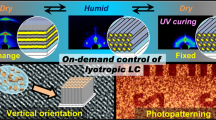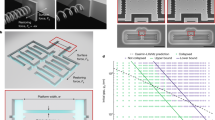Abstract
The supramolecular assembly of surfactant molecules at a solid–liquid interface can produce tubular structures with diameters of around 10 nm (refs 1,2,3,4), which can be used for the templated polymerization of mesoporous silica thin films3,4,5. The orientation of the tubules depends primarily on the nature of the substrate–surfactant interaction. These nanostructured films hold much promise for applications such as their use as orientated nanowires6, sensor/actuator arrays7,8,9 and optoelectronic devices10. But a method of patterning the tubules and orientating them into designed arrangements is required for many of these possibilities to be realized. Here we describe a method that allows the direction of growth of these tubules to be guided by infiltrating a reaction fluid into the microcapillaries of a mould in contact with a substrate11. An electric field applied tangentially to the surface within the capillaries induces electro-osmotic flow, and also enhances the rates of silica polymerization around the tubules by localized Joule heating. After removal of the mould, patterned bundles of orientated nanotubules remain on the surface. This method permits the formation of orientated mesoporous channels on a non-conducting substrate with an arbitrary microscopic pattern.
This is a preview of subscription content, access via your institution
Access options
Subscribe to this journal
Receive 51 print issues and online access
$199.00 per year
only $3.90 per issue
Buy this article
- Purchase on Springer Link
- Instant access to full article PDF
Prices may be subject to local taxes which are calculated during checkout



Similar content being viewed by others
References
Manne, S., Cleveland, J. P., Gaub, G. D., Stucky, G. D. & Hansma, P. K. Direct visualization of surfactant hemimicelles by force microscopy of the electric double layer. Langmuir 10, 4409–4413 (1994).
Manne, S. & Gaub, H. E. Molecular organization of surfactants at solid-liquid interfaces. Science 270, 1480–1482 (1995).
Yang, H., Kuperman, A., Coombs, N., Mamiche-Afara, S. & Ozin, G. A. Synthesis of oriented films of mesoporous silica on mica. Nature 379, 703–705 (1996).
Aksay, I. A. et al.Biomimetic pathways for assembling inorganic thin films. Science 273, 892–898 (1996).
Kresge, C. T., Leonowicz, M. E., Roth, W. J. & Beck, J. S. Ordered mesoporous molecular sieves synthesized by a liquid-crystal template mechanism. Nature 359, 710–712 (1992).
Li, W. Z. et al.Large-scale synthesis of aligned carbon nanotubes. Science 274, 1701–1703 (1996).
Sakai, H., Baba, R., Hashimoto, K., Fujishima, A. & Heller, A. Local detection of photoelectrochemically produced H2O2with a “wired” horseradish peroxidase microsensor. J. Phys. Chem. 99, 11896–11900 (1996).
Linder, E. et al.Flexible (kapton-based) microsensor arrays of high stability for cardiovascular applications. J. Chem. Soc. Faraday Trans. 89, 361–367 (1993).
Tamagawa, C. Y., Schiller, P. & Polla, D. L. Pyroelectric PbTiO3thin films for microsensensor applications. Sensors Actuators A 35, 77–83 (1992).
Fendler, J. H. Self assembled nanostructured materials. Chem. Mater. 8, 1616–1624 (1996).
Kim, E., Xia, Y. & Whitesides, G. M. Polymer microstructures formed by moulding in capillaries. Nature 376, 581–584 (1995).
Broers, A. N., Harper, J. M. & Molzen, W. W. 250-å linewidths with PMMA electron resist. Appl. Phys. Lett. 33, 392–394 (1978).
Fischer, P. B. & Chou, S. Y. 10 nm electron beam lithography and sub-50 nm overlay using a modified scanning electron microscope. Appl. Phys. Lett. 62, 2989–2991 (1993).
Flanders, D. Replication of 175-å lines and spaces in polymethylmethacrylate using x-ray lithography. Appl. Phys. Lett. 36, 93–96 (1980).
Early, K., Schattenberg, M. L. & Smith, H. I. Absence of resolution degradation in x-ray lithography for λ from 4.5 nm to 0.83 nm. Microelectron. Eng. 11, 317–321 (1990).
McCord, M. A. & Pease, R. F. P. Lithography with the scanning tunneling microscope. J. Vac. Sci. Technol. B 4, 86–87 (1986).
Kramer, N., Birk, J., Jorvitsma, M. & Schronenberger, C. Fabrication of metallic nanowires with a scanning tunneling microscope. Appl. Phys. Lett. 66, 1325–1327 (1995).
Chou, S. Y., Krauss, P. R. & Renstrom, P. J. Imprint lithography with 25-nanometer resolution. Science 272, 85–87 (1996).
Russel, W. B., Saville, D. A. & Schowalter, W. R. Colloidal Dispersions 212–235 (Cambridge Univ. Press, New York, 1989).
Scales, P. J., Grieser, F., Healy, T. W. & Magid, L. J. Electrokinetics of muscovite mica in the presence of adsorbed cationic surfactants. Langmuir 8, 277–282 (1992).
Iler, R. K. The Colloid Chemistry of Silica and Silicates 36–69 (Cornell Univ. Press, Ithaca, (1955)).
Lu, Y. et al.Continuous formation of supported cubic and hexagonal mesoporous films by sol-gel dip-coating. Nature 389, 364–368 (1997).
Morkved, T. L. et al.Local control of microdomain orientation in diblock copolymer thin films with electric fields. Science 273, 931–933 (1996).
Amundson, K. et al.Effect of an electric field on block copolymer microstructure. Macromolecules 24, 6546–6548 (1991).
Israelachvili, J. Intermolecular and Surface Forces 374 (Academic, London, (1992)).
Yang, H., Coombs, N. & Ozin, G. A. Mesoporous silica with micrometer-scale designs. Adv. Mater. 9, 811–814 (1997).
Acknowledgements
We thank L. Zhou, P. Fenter and P. M. Eisenberger for the X-ray diffraction characterization of the films. This work was supported by a MURI grant from the US Army Research Office and made use of the central facilities supported by an MRSEC programme of the NSF.
Author information
Authors and Affiliations
Corresponding author
Rights and permissions
About this article
Cite this article
Trau, M., Yao, N., Kim, E. et al. Microscopic patterning of orientated mesoscopic silica through guided growth. Nature 390, 674–676 (1997). https://doi.org/10.1038/37764
Received:
Accepted:
Published:
Issue Date:
DOI: https://doi.org/10.1038/37764
This article is cited by
-
Asymmetric Janus adhesive tape prepared by interfacial hydrosilylation for wet/dry amphibious adhesion
NPG Asia Materials (2019)
-
Unidirectional molecular assembly alignment on graphene enabled by nanomechanical symmetry breaking
Scientific Reports (2018)
-
Scale-dependent diffusion anisotropy in nanoporous silicon
Scientific Reports (2017)
Comments
By submitting a comment you agree to abide by our Terms and Community Guidelines. If you find something abusive or that does not comply with our terms or guidelines please flag it as inappropriate.



